Ultra Small C-Type Submarines (Japan)
Recall, according to the results of the operation of type “A” submarines in the middle of 1942, it was decided to develop a new project of more sophisticated equipment of similar purpose. In the new project “B” a diesel-electric power plant was used, replacing the pure electric one. Such an alteration of the base project submarines significantly increase the cruising range, as well as increase the autonomy of work, since the new boats did not need a special charging station for batteries. However, for several reasons, the submarines of the project “B” did not become widespread: only five units of such equipment were manufactured.
Deep upgrade
According to some reports, the reason for the delays in the assembly of all five submarines "B" were problems with the alteration of the existing hulls for new equipment. The need to dismantle some components and assemblies, followed by replacement with new ones, has affected the timing of the work. In addition, this feature of the first two projects, which, according to the designers, should have had a high degree of unification, showed that the approach to development was not justified. A new submarine had to be designed using existing components, but without trying to fit the necessary equipment into a not quite suitable, although existing, hull.
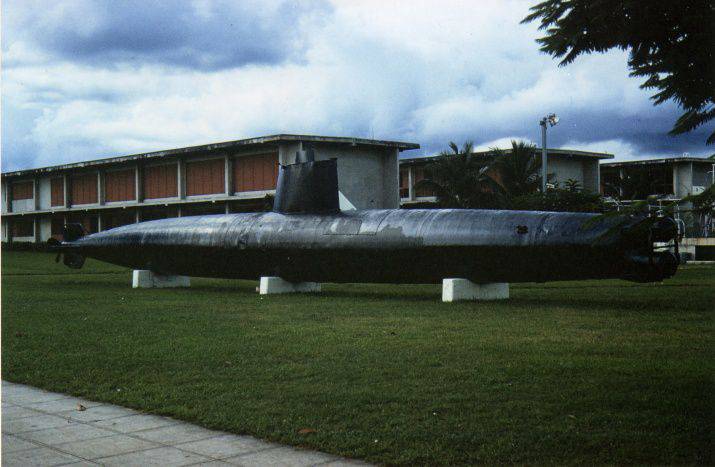
The only surviving C-type boat in the museum. Photo Aimmuseum.org
Thus, the main objective of the project "C" or "Hay-Gata" was the processing of the two previous submarines in order to simplify production. At the same time, it was proposed to introduce some innovations aimed at improving the technical characteristics and combat effectiveness. The result was that the submarines of types "A", "B" and "C" had some noticeable similarities, but differed from each other by different features.
It should be noted that a certain continuity was observed in the projects: all of them were based on common ideas and also provided for the use of common structures. This may indicate that the authors of the projects found, as they then thought, the best version of the appearance of the ultra-small submarine, and tried to develop it in order to achieve the desired characteristics.
The design of the submarine type "C"
Being a deep modernization of the submarine of type “B”, the new “Hay-Gata” should have had a similar one-and-a-half structure and a similar power plant. Such basic project ideas were considered quite viable and suitable for meeting existing requirements. Only some elements of a durable and lightweight body were modified, which was associated with the optimization of production and use of various units. As a result, the size and weight of the assembly was slightly changed.
The basis of the submarine type "C", as before, was a durable hull, assembled from 8-mm steel sheets. It consisted of a cylindrical bow and aft conical parts. The characteristics of the robust hull made it possible to dive to a depth of 100 m (according to other data, up to 100 feet - that is, no more than 30 m). Inside the strong hull housed the central post with crew jobs, batteries and power plant. The bow part of a complex shape was formed by a light body of relatively thin metal sheets. Outside the robust hull, torpedo tubes, compressed air tanks, ballast tanks, etc. were located.
The overall layout of the light and durable hulls remained the same and was borrowed from the previous project without major changes. Under the thin sheets of the light body there were two torpedo tubes located one above the other. Next to them were two ballast tanks, compressed air tanks, etc. Torpedo tubes passed along the entire length of the light body, and their front end protruded beyond its limits, forming characteristic protuberances.
In the nose of a strong body was the bulk of batteries for movement under water. Behind the battery compartment was the central post with the jobs of three submariners. Above the central post was located the cabin with sliding devices. Behind the submariners was aft engine compartment. It had additional batteries, as well as diesel and electric engines. Inside a solid hull housed several ballast tanks, both the main ballast, and balancing.
The composition of the power plant remained the same. It was proposed to use for movement in the surface position and recharging batteries at sea tank 40 hp diesel The power of the generator associated with it made it possible to fully charge all the batteries in 18 hours. An electric motor with a power of 600 hp was connected directly to the propeller shaft. Through a special gearbox, he rotated two coaxial screws.
On the outer surface of the submarine, a design was provided to protect torpedoes in apparatuses, saws and cables for cutting anti-submarine obstacles, as well as special frames for removing obstacles from chopping and dumping as aft. The rudders and propellers were protected from external influences by a cruciform design with an annular casing of screws.
The submarine type "C" turned out a little larger than the previous ones. Its length increased to 24,5 m, the maximum width to 1,9 m, the total height remained at the level of 3 m. The submerged displacement is now 49 t. You can see that the increase in size and weight of the structure was insignificant. Nevertheless, he still affected the characteristics of the boat. The maximum speed in the surface position was reduced to the 20-21 node, in the underwater position - to the 18-18,5 node. According to some sources, the maximum speed under water did not exceed 6-7 nodes.
The diesel-electric power plant in theory allowed to increase the cruising range, which was not enough for super small A-type submarines. Saving fuel and battery charge, the new Hay-Gata boats could be overcome in a surface position up to 500 nautical miles (at economic speeds of 6 knots). Underwater, the cruising range on a single battery charge was at the level of 120 miles (the speed of the 4 node).
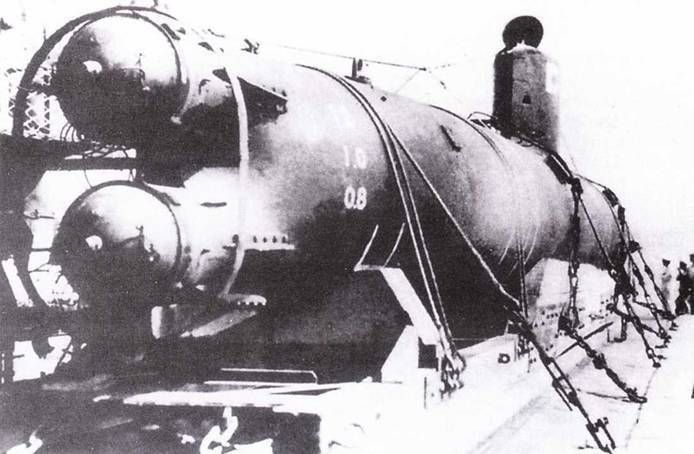
Submarine type "C" on the beach. Photo Coollib.com
The armament of the submarine of type “C”, as before, consisted of two torpedo tubes of caliber 450 mm. They were located in the bow of the submarine, under a light hull and partially protruded. Such devices were intended for the use of torpedoes "Type 97". Such torpedoes with a length of 5,6 m had a starting weight of 980 kg and carried an 350 kg of explosive. The engine, which worked on kerosene and oxygen, allowed the torpedo to accelerate to 45 nodes and overcome to 5,5 km. Despite its small caliber, similar weapon posed a serious danger to various ships.
The crew of the submarine type "C" consisted of three people: the commander, steering and minder. At their workplaces there was a set of compasses, instruments for monitoring the operation of systems and controls. It was suggested to monitor the environment and search for targets using a retractable periscope and hydrophone. Unlike some other equipment of this class, the Japanese ultra-small submarines "A", "B" and "C" were not equipped with cuttings with glazing. Submariners had to get to their workplaces through a manhole in the wheelhouse.
Winemaking
Ultra-small submarines "Hay-Gata" replaced on the stocks of all their predecessors. Serial construction of such equipment began in the late autumn of 1943. By this time, in the shops of the factories engaged in the project, there were several unfinished submarines of type "A", which were completed under the project "B". New boats of type “C” were built without using the reserve by previous orders. In accordance with the signed contract, the fleet was to receive about 50 new submarines.
As the next upgrade option for the “A” submarine, the new “C” received similar serial numbers of the “Ha-NN” type. As far as we know, serial “Hay-Gata” numbers were from 54 to 100. The existence of submarines with numbers more than a hundred has not been confirmed. It should be noted that the serial number was not used. fleet. Submarines involved in certain operations were designated by the name of the carrier submarine. Thus, in some cases, problems may arise with the accurate identification of boats participating in various operations.
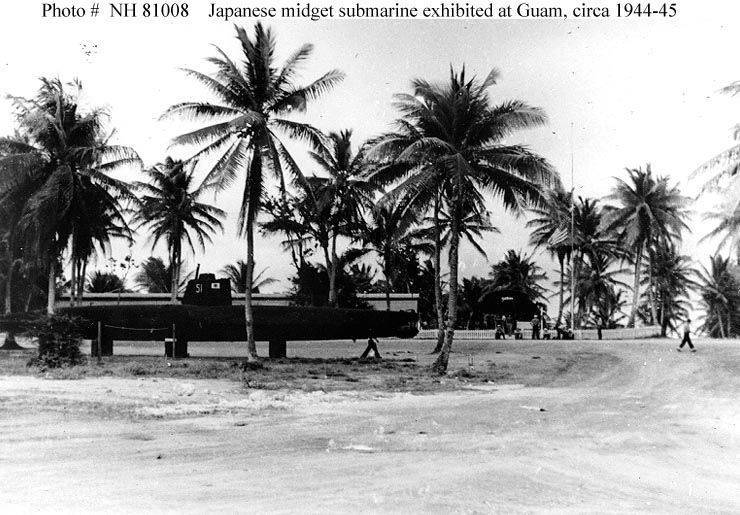
The only surviving submarine "Hay-Gata" in the middle 40-s. Photo Ibiblio.org
There is evidence of some reduction in the order for combat submarines of the new project. So, from 47 built boats 10 were converted into training. In the course of such refinement, they received an updated set of onboard equipment. The most noticeable consequence of this alteration was an increase in the length of the cabin. To accommodate additional equipment and an instructor who was responsible for the preparation of future submariners, it was necessary to significantly alter the central post and habitable volume as a whole.
The construction of ultra-small C-class submarines continued until the autumn of the 1944 year. During this time, the Imperial fleet received 47 submarines: 37 combat and 10 training. All this equipment was transferred to units that have already exploited similar submarines of previous models.
Exploitation
Initially, Japanese ultra-small submarines were to be transported to the place of operation by specially converted surface ships. Nevertheless, the experience of fighting in the Pacific showed that this method of delivering boats could lead to increased losses, since it does not provide an acceptable transportation secrecy. Because of this, all type "A" submarines were delivered to the desired area using submarines from the fleet.
In the middle of 1943, the idea of a ship-transport was returned. By the end of the year, several such ships were equipped, which received special equipment for servicing and transporting ultra-small boats. However, this time the carrier ship was not supposed to deliver submarines to the site of the operation. Converted ships were intended only for the transport of "Hay-Gat" to the new classified bases.
There is information about the delivery of at least 15-20 submarines to special bases on. Okinawa and the Philippines. There they were supposed to patrol specified areas and, if appropriate, attack enemy ships and ships. Type A submarines were previously used to attack enemy naval bases, but suffered heavy losses. Given this sad experience, the fleet command decided to abandon such bold raids and use ultra-small submarines exclusively for free hunting in important areas.
Ultra-small type “B” submarines were delivered to several bases located on the Philippine Islands and Okinawa. Thus, the Philippine bases were located on the islands of Mindanao (the bases of Davao and Zamboanga) and Cebu (the base of the same name). All a dozen submarines conducted patrols, but only submariners from the Cebu base participated in the battles. For several months, they continued to patrol the aforementioned water areas and look for potential targets, until Cebu Island passed into the hands of the Americans.
The combat work of ultra small submarines most often looked like this. Having gone into the sea, the crew of the boat was heading for the southern tip of Fr. Negros, to the base of Dumaguete. Near this place, ships and ships of the United States regularly traveled, which made it possible to hope for successful detection and destruction of targets. Upon arrival at the base of Dumaguete, the submarines went to drift or approached the coast. Then they could only wait for the message of the advanced observers and the suitable courts of the enemy. As a result, the submarines were in a timely manner in the path of enemy ships and did not waste fuel or battery power.
Active navigation in the area and an interesting strategy allowed the Japanese submariners to make regular attempts to attack enemy ships. However, most reports of crews of submarines of type “C” are not confirmed in American sources. For example, on January 3, submariners reported the sinking of two transport ships and one destroyer. 5 January, according to reports from the Philippine bases, two American warships were scuttled into the sea of Mindanao. The price of this victory was the loss of one of the submarines. Indeed, on this day, Japanese submarines attempted to attack the American convoy. However, the cruiser USS Boise (CL-47) on time received a message about the attack from one of the other ships and managed to dodge. The submarine was spotted from the destroyer USS Taylor (DD-468), attacked and sunk.
In February, 45 from the Japanese base in Cebu was reported to be sinking with ultra small submarines of two enemy ships. In March, according to Japanese officers, three vehicles were sunk. However, these attacks are not supported by US sources. Probably, the submariners tried to record on their own account even unsuccessful attacks. Outlets at sea for the attacks continued until the end of March.
26 March 1945, US troops during the Philippine operation began landing on the island of Cebu. By the time the base was captured, the Japanese had time to flood the five ultra-small “B” submarines that remained in the port. The rest by this time had time to go out to sea and made an attempt to counteract the landing party. During the landing, several American ships had contact with Japanese submarines. The destroyer USS Newman (DE-205) was able not only to detect, but also to fire at the enemy. Artillery fire, he sank one of the enemy submarines, trying to attack ships.
Results
According to reports, the super small submarines of type “C”, based on the island of Cebu, were the only representatives of their project who participated in the battles. Submarines of other bases patrolled in various areas, but there is no information about attempts to launch attacks, not to mention the successful torpedoing of enemy ships. Apparently, only those boats that were based near the main sea routes took part in the battles.
From a technical point of view, the project “C” or “Hay-Gat” turned out to be quite successful. By the end of 1943, the Japanese specialists succeeded, as they say, in bringing to mind the project of a super-small submarine, begun in the first half of the 1930s. The result of this was the emergence of ultra-small submarines with fairly high performance and good combat potential. Navigation range to 500 nautical miles, the possibility of a long stay under water and ammunition from two relatively powerful torpedoes allowed new boats to participate in free hunting and raids on enemy bases.
However, the submarines with the required characteristics appeared too late. By the beginning of 1944, the war in the Pacific was not in favor of Japan. The Allied countries increased their ship and land grouping, which allowed them to win one island after another. As a result, Japan was no longer able to make full-fledged raids using ultra-small submarines like operations in Pearl Harbor or off the coast of Sydney. New promising technology had to be sent to the Philippine Islands and used in attempts to attack passing ships. Naturally, this strategy did not bring tangible results.
Thus, the project successful from the point of view of technology turned out to be unpromising in terms of real results of combat work. Submarines of type “C” were late for the war and did not have time to influence the course of the hostilities. However, the Japanese admirals and engineers have not lost interest in such equipment. At the beginning of 1944, the development of the project “D”, also known as “Tay-Gata” and “Koryu”, started. These boats were to be used to protect the Japanese coast.
During 1944, the Japanese Imperial fleet received a little less than fifty C-type submarines in combat and training configurations. Almost all of this technique was destroyed during the fighting or was submerged in front of the advancing enemy. Only one ultra-small submarine “Hay-Gata” survived to our time. From the mid-forties, when it was lifted from the bottom of the sea, this submarine is located in a museum on the island of Guam. At the beginning of the two thousandth, this museum exhibit was restored, and it is again shown to tourists.
On the materials of the sites:
http://combinedfleet.com/
http://war-only.com/
http://navsource.org/
http://modelist-konstruktor.com/
http://aimmuseum.org/
http://pacificwrecks.com/
http://aimmuseum.org/
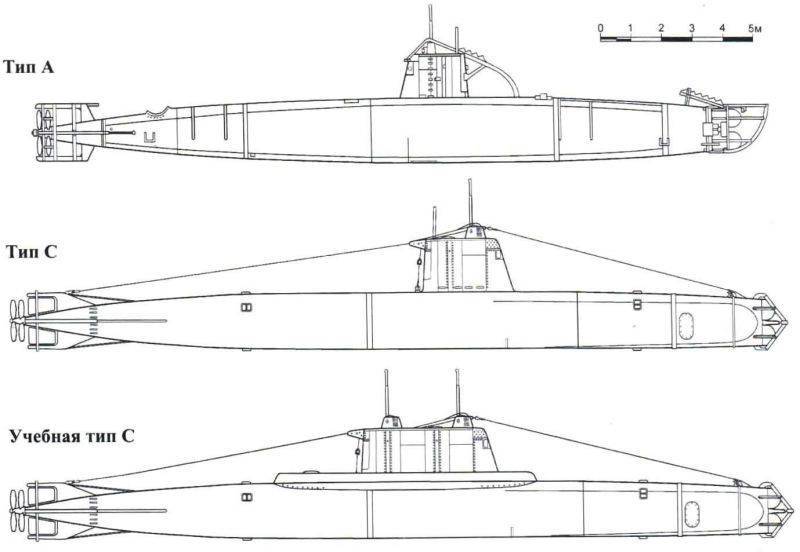
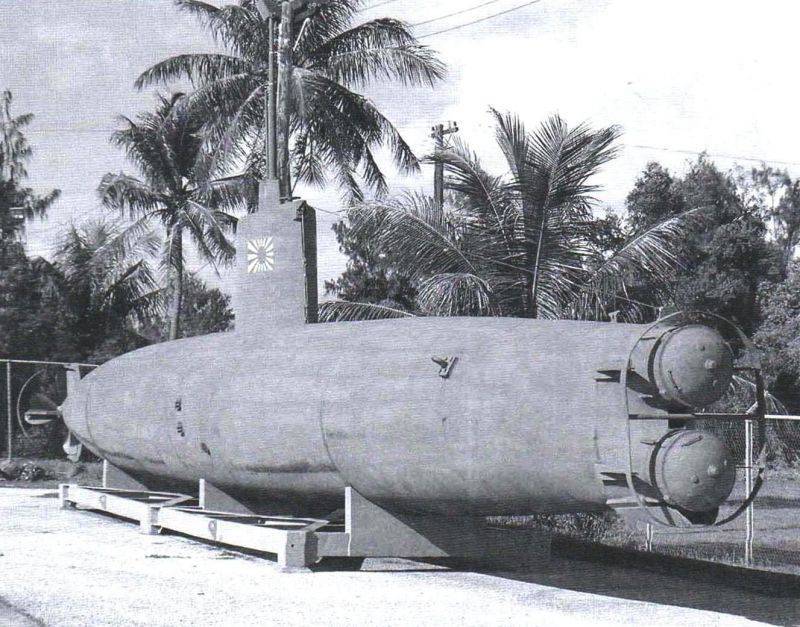
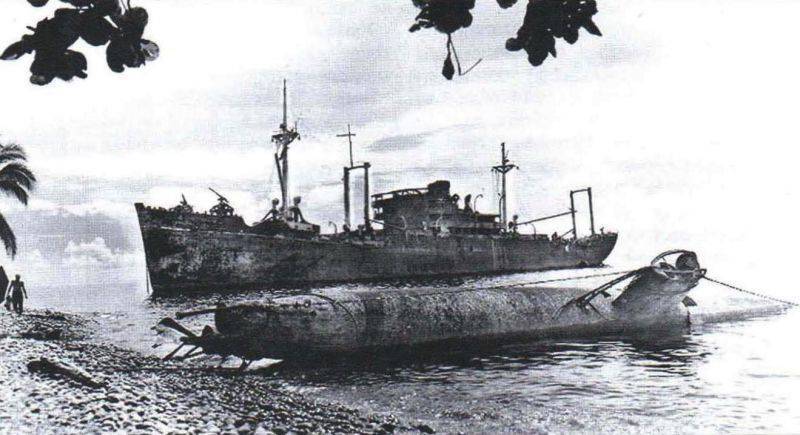
Information